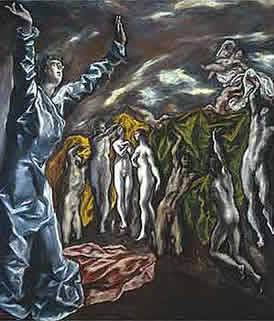Manolo Millares: The Destruction and the Love
by G. Fernández – theartwolf.com
Few artistic periods are so difficult to study as the European informalism from the 50s and 60s. Rejecting the geometric abstractions popularized after the World War II, the term “informalism” -first appearing during an exhibition in a Paris gallery in 1951- grouped a series of artistic modalities -gesture painting, calligraphic painting, painting of signs, material painting- that had in common the absolute prominence of the pictorial material.
In Spain, these European vanguard tendencies had their reflection with the creation in 1957 of the group “El Paso” (“The Step”), formed by artists such as Antonio Saura, Manolo Millares, Luis Feito or Rafael Canogar, in which gesture painting prevailed as the main form of artistic expression. One of these artists went beyond the simple gesture and developed a complex material, even three-dimensional painting: Manolo Millares (1926-1972), an artist from the Canary Islands to whom the Caixa Galicia Foundation dedicates a exhibition -with the suggestive but also not clarifying title of “The destruction and the love”, expression taken from a poem by Vicente Aleixandre- that reunites the most distinguished of his oeuvre.
Radically monographic, even out of context -there is no trace of artists with whom Millares had direct contact, for example the other members of the group “El Paso” like Antonio Saura or Luis Feito-, the exhibition constitutes a complete trip – arguably the most complete ever made- through the work of the canary artist. First influenced by the surrealism -which seems inevitable in the case of artists from the Canary Islands-, his art changed after he moved to Madrid in 1955 and his joined the Group “El Paso”. Millares began his experimentation with the material painting, created on broken, torn, twisted burlaps. An art easily identifiable with the “black Spai ” of the time, an art that “destroys itself so as to rebuild itself’ ipso facto’ from its ruins”. Representative works are his series of “Humboldt in the Orinoco” or his large paintings numbered and simply entitled “Cuadro” (“Picture”)
“Deep down I continue being there, at the bottom of the Earth, and I believe that that is the place which I should have never left”, Millares wrote. His painting has a certain shade of “human archaeology”, a tool that penetrates into the nature of the human being, resulting in works such as the “Homúnculos” series or the “Fallen Personage”.
In 1969 Millares made a trip to the Sahara, returning impressed by the white tones of the sand, which is reflected in his posterior paintings. “The white has always played a very important role in my painting”, affirmed Millares. It is a distressing white, the colour of the emptiness, of the unanswered questions, reflected in works as “Antropofauna” or the double picture of “Adam” and “Eve”
We also have to mention the sculptures created by Millares, represented in the exhibition by three examples of his “Artefactos para la Paz” (“Artefacts for the Peace”), an ironic celebration of the “25 years of Peace” in Spain.
The influence of Millares -as the other members of the Group “El Paso”- is evident in contemporary Spanish artists like Tàpies or Barceló. The name of Millares is already quite sought-after in the contemporary art market, although still a step below his contemporary Antonio Saura. His most important works that remain in private hands sell for prices that have surpassed the 300.000 euros at auction houses like Christie’s or Sotheby’s
Manolo Millares: “The destruction and the love” In the Caixa Galicia Foundation till October 20th 2006. Read more at fundacióncaixagalicia.org
Manolo Millares: Cuadro 92, 1961
.© Manolo Millares – Caixa Galicia Collection
Manolo Millares: Cuadro 92, 1961 (detail)
© Manolo Millares
Manolo Millares: Cuadro 167, 1960-62
© Manolo Millares – Azcona Collection, Madrid
Follow us on:


